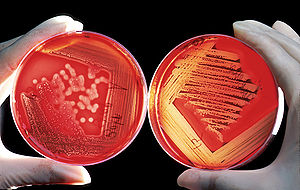Scientists from the University of Alberta awoke this Monday to a shocking discovery: the bacteria they were trying to grow on an agar bed refused to eat it.
The team had been researching the effect of certain antibiotics on E. Coli in order to determine how fast they developed a resistance to them. The experiment had been going on for more than three months without any incident until, last Monday, the bacteria said “enough.” The team left a Petri dish full of agar and a sample of E. Coli during the night, only to find it completely untouched.
“Agar is known to be bacteria’s favorite food” explains Alan Fiddle, project leader. “Every single researcher on Earth uses it. We might have found the first ‘gourmet bacteria’ in history.”
Researchers believe they have found the first “gourmet bacteria”
E. Coli grow in the intestines of human beings and are used to a certain variety of food, which might explain their reluctance to eat the Agar. “I guess after three months of having the same meal every day they got pretty bored” says James Gilbert, a research assistant. “We actually tried feeding them lemon Jell-O and they went back to eating, so maybe they thought agar was too bland.”
Researchers now are trying to sequence the genome of the rebellious bacteria, trying to discern the causes of their unexpected behavior. “Bacteria have the ability to exchange genes with each other, so mutations spread really quickly” explained Fiddle. “If this gets out and starts affecting other bacteria populations, it could completely paralyze most of the world’s biological research. It is a serious situation.”
If the mutation spreads it will threaten the world’s biological research
For the moment, researchers are trying to convince their bacteria to eat agar again with tricks such as changing the color of the food source or showing pictures of other, happy bacteria enjoying their meal.
“So far they’re not buying it” says Gilbert. “They are smarter than we thought.”


















